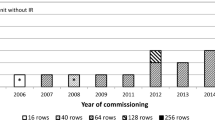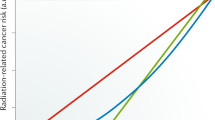Abstract
Background
Urological investigation in children frequently involves high radiation doses; however, the issue of radiation for these investigations receives little attention compared with CT.
Objective
To compare the radiation dose from paediatric urological investigations with CT, which is commonly regarded as the more major source of radiation exposure.
Materials and methods
We conducted a retrospective audit in a tertiary paediatric centre of the number and radiation dose of CT scans, micturating cystourethrography exams and urological nuclear medicine scans from 2006 to 2011. This was compared with radiation doses in the literature and an audit of the frequency of these studies in Australia.
Results
The tertiary centre audit demonstrated that the ratio of the frequency of urological to CT examinations was 0.8:1 in children younger than 17 years. The ratio of the radiation dose of urological to CT examinations was 0.7:1. The ratio in children younger than 5 years was 1.9:1. In Australia the frequency of urological procedures compared with CT was 0.4:1 in children younger than 17 years and 3.1:1 in those younger than 5 years. The ratio of radiation-related publications was 1:9 favouring CT.
Conclusion
The incidence and radiation dose of paediatric urological studies is comparable to those of CT. Nevertheless the radiation dose of urological procedures receives considerably less attention in the literature.


Similar content being viewed by others
References
Goske MJ, Applegate KE, Boylan J et al (2008) The image gently campaign: working together to change practice. AJR Am J Roentgenol 190:273–274
Finnell SM, Carroll AE, Downs SM et al (2011) Subcommittee on urinary tract infection. Technical report—diagnosis and management of an initial UTI in febrile infants and young children. Pediatrics 128:e749–e770
Ditchfield MR, De Campo JF, Cook DJ et al (1994) Vesicoureteral reflux: an accurate predictor of acute pyelonephritis in childhood urinary tract infection? Radiology 190:413–415
Williams G, Craig JC (2011) Long-term antibiotics for preventing recurrent urinary tract infection in children. Cochrane Database Syst Rev (3):CD001534. doi:10.1002/14651858.CD001534.pub3
National Collaborating Centre for Women’s and Children’s Health (2007) Urinary tract infection in children: diagnosis, treatment and long-term management. National Institute for Health and Clinical Excellence, RCOG Press, London. http://www.nice.org.uk/nicemedia/live/11819/36032/36032.pdf. Accessed 14 January 2013
Medicare Australia Statistics—Medicare Item Reports. https://www.medicareaustralia.gov.au/statistics/mbs_item.shtml. Cited 14 April 2012
Valentin J (2007) Managing patient dose in multi-detector computed tomography (MDCT). ICRP Publication 102. Ann ICRP 37:1–79
International Commission on Radiological Protection (1998) Radiation dose to patients from radiopharmaceuticals (addendum 2 to ICRP Publication 53). ICRP Publication 80. Ann ICRP 28:1–126. http://www.icrp.org/publication.asp?id=ICRP%20Publication%2080 Accessed 14 January 2013
Schultz FW, Geleijns J, Holscher HC et al (1999) Radiation burden to pediatric patients due to micturating cystourethrography examinations in a Dutch children’s hospital. Br J Radiol 72:763–772
González L, Vañó E, Ruiz MJ (1995) Radiation doses to paediatric patients undergoing micturating cystourethrography examinations and potential reduction by radiation protection optimization. Br J Radiol 68:291–295
Fotakis M, Molyvda Athanasopoulou E, Psarrakos K et al (2003) Radiation doses to paediatric patients up to 5 years of age undergoing micturating cystourethrography examinations and its dependence on patient age: a Monte Carlo study. Br J Radiol 76:812–817
Sulieman A, Theodorou K, Vlychou M et al (2007) Radiation dose measurement and risk estimation for paediatric patients undergoing micturating cystourethrography. Br J Radiol 80:731–737
Ruiz MJ, Vañó E, González L et al (1996) Dose-area product values in frequently performed complex paediatric radiology examinations. Br J Radiol 69:160–164
Almén A, Mattsson S (1995) The radiation dose to children from X-ray examinations of the pelvis and the urinary tract. Br J Radiol 68:604–613
Chapple CL, Faulkner K, Lee RE et al (1992) Results of a survey of doses to paediatric patients undergoing common radiological examinations. Br J Radiol 65:225–231
Ward VL, Strauss KJ, Barnewolt CE et al (2008) Pediatric radiation exposure and effective dose reduction during voiding cystourethrography. Radiology 249:1002–1009
Thomas KE, Wang B (2008) Age-specific effective doses for pediatric MSCT examinations at a large children’s hospital using DLP conversion coefficients: a simple estimation method. Pediatr Radiol 38:645–656
Kim S, Yoshizumi TT, Frush DP et al (2010) Radiation dose from cone beam CT in a pediatric phantom: risk estimation of cancer incidence. AJR Am J Roentgenol 194:186–190
Nauer CB, Rieke A, Zubler C et al (2011) Low-dose temporal bone CT in infants and young children: effective dose and image quality. Am J Neuroradiol 32:1375–1380
Fahey FH, Treves ST, Adelstein SJ (2011) Minimizing and communicating radiation risk in pediatric nuclear medicine. J Nucl Med 52:1240–1251
Smith T, Evans K, Lythgoe MF et al (1996) Radiation dosimetry of technetium-99m-DMSA in children. J Nucl Med 37:1336–1342
Smith T, Gordon I, Kelly JP (1998) Comparison of radiation dose from intravenous urography and 99Tcm DMSA scintigraphy in children. Br J Radiol 71:314–319
Peters CA, Skoog SJ, Arant BS Jr et al (2010) Summary of the AUA guideline on management of primary vesicoureteral reflux in children. J Urol 184:1134–1144
Shapiro E, Snow B, Zaontz M (2003) Management of vesicoureteral reflux. Rev Urol 5:121–125
Becker AM (2009) Postnatal evaluation of infants with an abnormal antenatal renal sonogram. Curr Opin Pediatr 21:207–213
North American Consensus Guidelines for Administered Radiopharmaceutical Activities in Children and Adolescents. Available via: http://www.pedrad.org/associations/5364/files/ImGen11_Nu_Med_Poster.pdf Accessed 14 January 2013
Shneider K, Perlmutter N, Arthur R et al (2000) Micturition cystourethrography in pediatric patients in selected children’s hospitals in Europe: evaluation of fluoroscopy technique, image quality criteria and dose. Radiat Prot Dosimetry 90:197–201
Conflicts of interest
None
Author information
Authors and Affiliations
Corresponding author
Rights and permissions
About this article
Cite this article
Page, M., Florescu, C., Johnstone, L. et al. Paediatric urological investigations—dose comparison between urology-related and CT irradiation. Pediatr Radiol 43, 846–850 (2013). https://doi.org/10.1007/s00247-013-2635-z
Received:
Revised:
Accepted:
Published:
Issue Date:
DOI: https://doi.org/10.1007/s00247-013-2635-z




